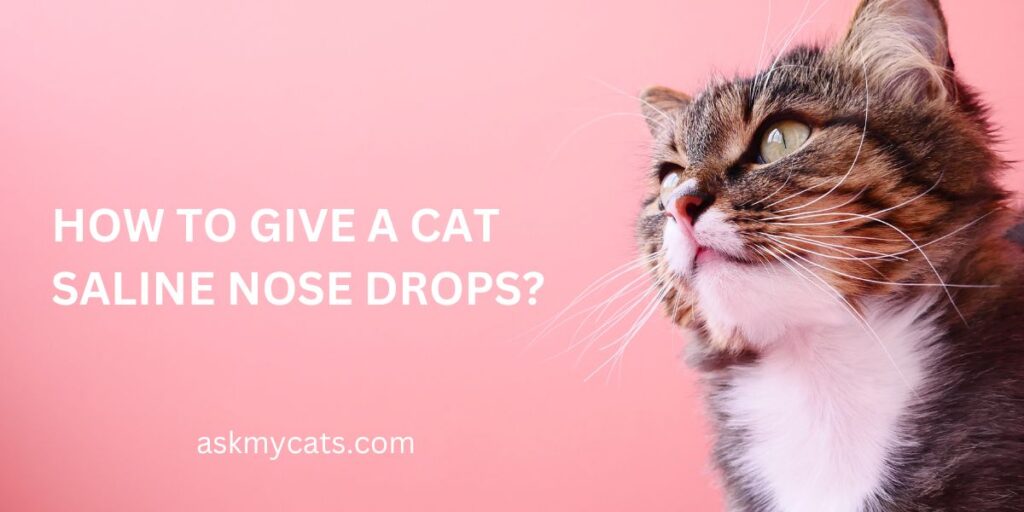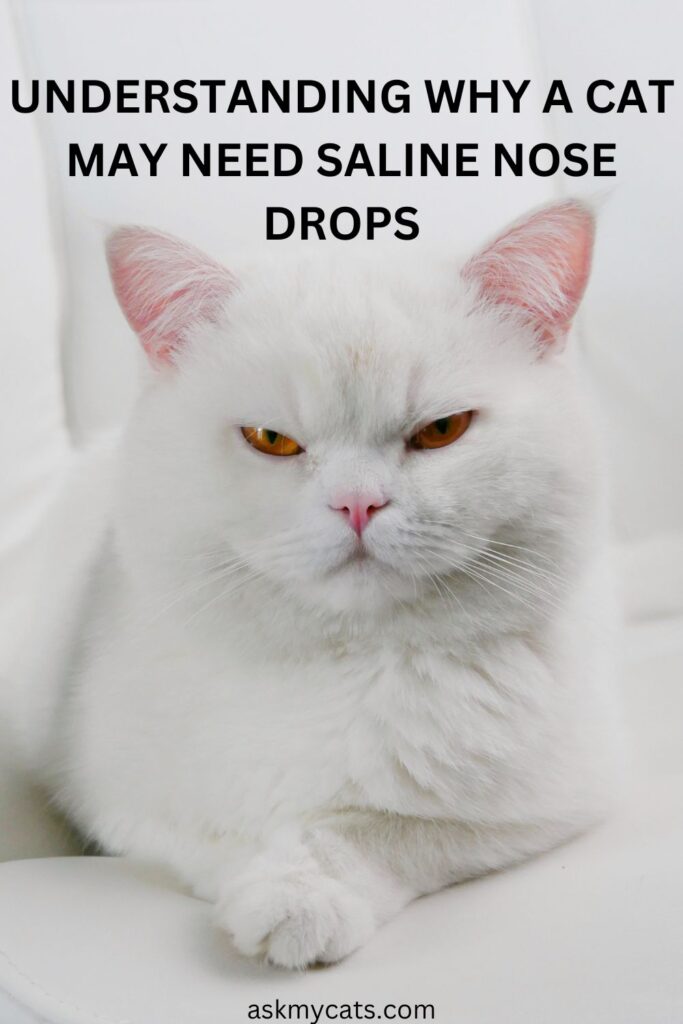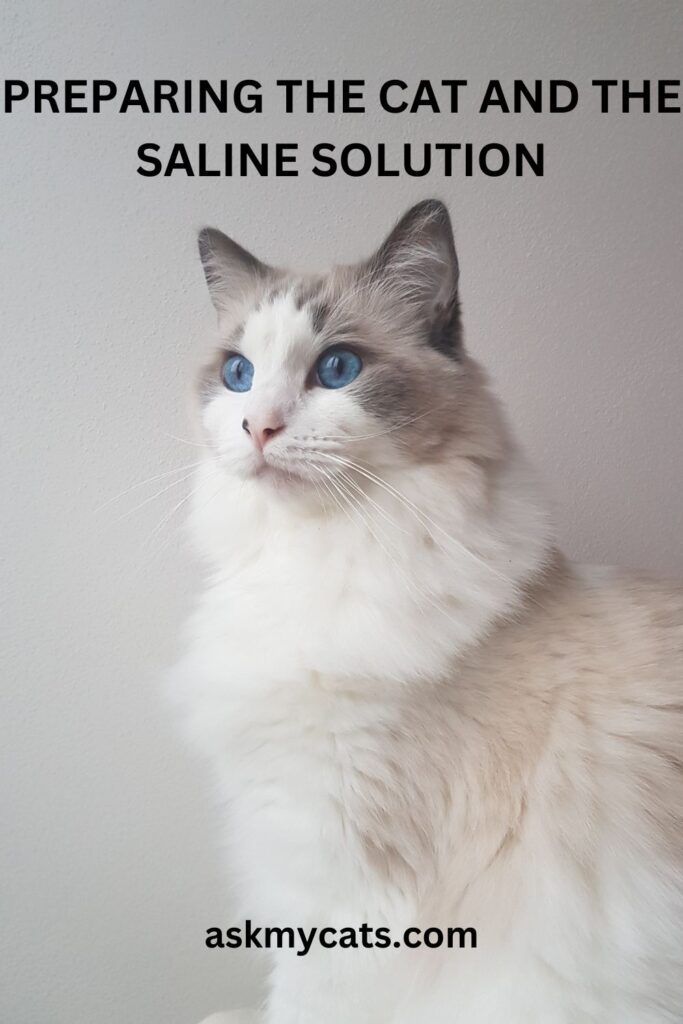As a cat owner, you know how important it is to keep your furry friend healthy and happy. However, sometimes our feline companions can fall ill, and administering medication can be a daunting task.
If your cat is suffering from a respiratory infection or other nasal issues, your vet may recommend saline nose drops to provide relief.
While the thought of giving your cat nose drops might make you nervous, it’s a straightforward process that you can master with a bit of patience and preparation.
In this article, we’ll guide you through the steps to safely and effectively give your cat saline nose drops, so your furry friend can breathe easy and get back to their playful self.
Key Takeaways
- Saline nose drops can be used to relieve nasal issues in cats such as respiratory infections, allergies, dry air, or foreign objects.
- Before administering saline nose drops, prepare the saline solution and your cat by finding a quiet and comfortable area, tilting your cat’s head back, and using a dropper to place one or two drops in each nostril.
- Gently massage your cat’s nose after administering the drops and reward your cat for cooperation.
- Tips for administering saline nose drops include using a calm and quiet environment, holding your cat securely, tilting your cat’s head back, administering the drops slowly, massaging the nose, and cleaning up any spills immediately.


Give Your Cat the Perfect Day
Get the Free Ebook!
Are Saline Drops Safe For Cats?
Yes, saline drops are generally safe for cats when used as directed by a veterinarian. Saline drops are a solution of salt and water, and they can help to loosen and remove mucus and other irritants from the nasal passages, making it easier for your cat to breathe.
They are often recommended for cats with respiratory infections, allergies, or other nasal issues.
However, it’s important to use only saline drops that are specifically made for cats and to follow your veterinarian’s instructions carefully.
You should never use saline drops that contain other ingredients, such as decongestants or antihistamines, as these can be harmful to cats.
Understanding Why A Cat May Need Saline Nose Drops

There are several reasons why a cat may need saline nose drops. Some of the most common reasons include:
- Respiratory infections: Cats are susceptible to viral and bacterial infections that can cause nasal congestion, sneezing, and discharge. Saline nose drops can help to relieve these symptoms by loosening mucus and other irritants in the nasal passages.
- Allergies: Cats can also suffer from allergies that cause nasal congestion, sneezing, and itching. Saline nose drops can help to soothe and moisturize the nasal passages, reducing the inflammation and irritation caused by allergies.
- Dry air: In dry environments, the nasal passages can become dry and irritated, leading to discomfort and congestion. Saline nose drops can help to add moisture to the nasal passages, making it easier for your cat to breathe.
- Foreign objects: Cats are curious creatures and may sometimes get foreign objects, such as grass or small toys, stuck in their nasal passages. Saline nose drops can help to loosen and remove these objects, reducing the risk of infection and other complications.
Must Read: Effective Home Remedies for Cat Nasal Congestion
Preparing The Cat And The Saline Solution

Before administering saline nose drops to your cat, it’s important to properly prepare both your cat and the saline solution.
Here’s what you’ll need to do:
- Prepare the saline solution: You can purchase saline nose drops made specifically for cats from your veterinarian or a pet supply store. Alternatively, you can make your own saline solution by mixing 1/4 teaspoon of non-iodized salt with 1 cup of distilled or boiled water. Make sure the solution is at room temperature before use.
- Prepare your cat: Before administering the saline drops, it’s important to calm and prepare your cat. Find a quiet and comfortable area where you can administer the drops without distractions. You may want to wrap your cat in a towel or blanket to help keep them still.
- Position your cat: Gently hold your cat in your lap or place them on a table. Tilt your cat’s head back slightly so that its nostrils are facing upward.
- Administer the saline drops: Using the dropper provided with the saline solution, place one or two drops into each of your cat’s nostrils. Avoid touching the dropper to your cat’s nostrils to prevent contamination.
- Massage the nose: Gently massage your cat’s nose to help distribute the saline drops throughout the nasal passages.
- Reward your cat: After administering the saline drops, offer your cat a treat or praise to reward them for their cooperation.
Must Read: How To Clean A Cat’s Nose? Safely and Effectively!
Administering The Drops Safely And Effectively
Administering saline nose drops to a cat can be a bit tricky, but with a little practice, you can do it safely and effectively. Here are some tips to help you administer the drops:
- Use a calm and quiet environment: Choose a quiet room to administer the saline drops, and avoid any distractions that may startle or stress your cat.
- Hold your cat securely: It’s important to hold your cat securely to prevent them from moving or squirming during the process. You may want to wrap your cat in a towel or blanket to help keep them still.
- Tilt your cat’s head back slightly: Gently tilt your cat’s head back so that its nostrils are facing upward. This will help the saline drops flow into the nasal passages more easily.
- Administer the drops slowly: Squeeze the dropper slowly to release one or two drops into each nostril. Avoid touching the dropper to your cat’s nostrils to prevent contamination.
- Massage the nose: After administering the drops, gently massage your cat’s nose to help distribute the saline solution throughout the nasal passages.
- Reward your cat: After administering the drops, offer your cat a treat or praise to reward them for their cooperation.
- Clean up any spills: If any saline solution spills, be sure to clean it up immediately to prevent your cat from ingesting it.
Interesting Read: How To Make A Cat Sneeze To Clear Nose?
Monitoring The Cat’s Response To The Treatment
After administering saline nose drops to your cat, it’s important to monitor their response to the treatment. Here are some things to watch for:
- Improved breathing: One of the main goals of administering saline nose drops is to improve your cat’s breathing. Watch for signs that your cat is breathing more easily and comfortably.
- Decreased nasal discharge: Saline nose drops can help to loosen and remove mucus and other irritants from the nasal passages. Watch for a decrease in nasal discharge or other signs of congestion.
- No adverse reactions: Saline nose drops are generally safe for cats, but in rare cases, they can cause adverse reactions such as sneezing, coughing, or vomiting. If you notice any unusual symptoms or reactions after administering the drops, contact your veterinarian right away.
- Compliance with the treatment: Administering saline nose drops to a cat can be challenging, so it’s important to monitor your cat’s compliance with the treatment. If your cat becomes resistant or stressed during the process, talk to your veterinarian about alternative treatments or techniques.
- Follow-up with the veterinarian: Depending on the underlying cause of your cat’s symptoms, your veterinarian may recommend additional treatments or follow-up appointments. Be sure to follow their instructions and keep them informed of your cat’s progress.
Must Read: All About Cat Nasal Congestion
Tips For Making The Process Less Stressful For Both The Cat And For You
Administering saline nose drops to a cat can be a stressful experience for both the cat and the owner. Here are some tips to make the process less stressful:
- Start slowly: If your cat is resistant to having their nose touched, start slowly by gently touching and massaging its nose. Gradually work up to administering the saline drops over time.
- Use positive reinforcement: Offer your cat a treat or praise after administering the drops to reinforce good behavior and help them associate the process with positive experiences.
- Use a distraction: Distract your cat during the process by using a favorite toy or treat to keep them occupied.
- Be gentle: Use a gentle touch when administering the drops and avoid any sudden movements or loud noises that may startle your cat.
- Stay calm: Your cat can sense your emotions, so it’s important to remain calm and relaxed during the process to help your cat feel at ease.
- Enlist help: If administering the drops is too challenging, consider enlisting the help of a friend or family member to assist you.
- Talk to your veterinarian: If your cat continues to be resistant or stressed during the process, talk to your veterinarian about alternative treatments or techniques that may be less stressful for your cat.
Interesting Read: Effective Home Remedies for Cat Runny Nose
When To Consult A Veterinarian For Additional Treatment
While saline nose drops can be helpful in treating certain conditions in cats, there are situations where additional treatment may be necessary.
Here are some signs that you should consult a veterinarian for additional treatment:
- Persistent or worsening symptoms: If your cat’s symptoms persist or worsen after administering saline nose drops, it may indicate an underlying condition that requires additional treatment.
- Discharge changes color: If the discharge from your cat’s nose changes color from clear to yellow or green, it may be a sign of a bacterial infection that requires antibiotics.
- Difficulty breathing: If your cat is having difficulty breathing, it’s important to seek immediate veterinary care. This may indicate a serious respiratory condition that requires prompt treatment.
- Swelling or inflammation: If your cat’s nose appears swollen or inflamed, it may be a sign of an underlying condition that requires veterinary attention.
- Changes in behavior: If your cat’s behavior changes, such as decreased appetite, lethargy, or increased agitation, it may indicate an underlying condition that requires veterinary attention.
Interesting Read: Runny Cat Nose: Causes, Symptoms, and Remedies
Can I Use Human Nasal Drops For Cats?
It is not recommended to use human nasal drops for cats without consulting with a veterinarian first. Human nasal drops may contain ingredients that are not safe or appropriate for use in cats and could cause harm.
Additionally, cats may require a different dosage or frequency of treatment than what is recommended for humans.
It is important to always use products that are specifically formulated for cats and to follow the advice and guidance of a veterinarian.
Homemade Saline Solution For Cats Nose
While it is important to use a saline solution that is specifically formulated for cats, it is possible to make a homemade saline solution that is safe and effective for your cat’s nose.
Here’s a recipe for a homemade saline solution for cats:
Ingredients:
- 1 cup of distilled water
- 1 teaspoon of non-iodized salt
Instructions:
- Boil the water for 5-10 minutes to sterilize it.
- Let the water cool to room temperature.
- Add 1 teaspoon of non-iodized salt to the water and stir until it dissolves completely.
- Pour the saline solution into a clean dropper bottle or syringe.
- The solution can be stored in the refrigerator for up to a week.
When using a homemade saline solution, it’s important to make sure that all utensils and containers are clean and sterile to prevent contamination.
Alternative Methods For Providing Nasal Hydration

In addition to saline nose drops, there are alternative methods for providing nasal hydration to cats. Two options are saline sprays and humidifiers.
Saline sprays work in a similar way to nose drops, but they are sprayed directly into the nose rather than dropped in. Saline sprays can help to moisten the nasal passages and loosen any mucus, making it easier for your cat to breathe.
However, it’s important to use a saline spray specifically formulated for cats, as human sprays may contain ingredients that are not safe for feline use.
Humidifiers can also be helpful in providing nasal hydration to cats. These devices increase the moisture in the air, which can help to relieve dryness in the nasal passages and make it easier for your cat to breathe.
However, it’s important to use a humidifier that is designed for use with pets, as some humidifiers can release harmful chemicals or bacteria that could be harmful to your cat.
Frequently Asked Questions
Can saline nose drops help with cat colds and respiratory infections?
Saline nose drops can help to relieve symptoms associated with cat colds and respiratory infections, but it’s important to consult with a veterinarian to determine the underlying cause and appropriate treatment.
Can I use human saline nose drops for my cat?
It’s not recommended to use human saline nose drops for cats without consulting with a veterinarian first, as these drops may contain ingredients that are not safe or appropriate for feline use.
Final Words
In conclusion, saline nose drops can be a safe and effective treatment for cats with certain respiratory conditions, but it’s important to follow the guidance of a veterinarian and only administer drops or alternative methods as directed.
Additionally, it’s important to monitor your cat’s response to treatment and seek veterinary care if symptoms persist or worsen.
By working with a veterinarian and taking a proactive approach to your cat’s health, you can help to ensure that your furry friend stays healthy and happy.
Interesting Read: Why Does My Cat Have A Dry Nose?
